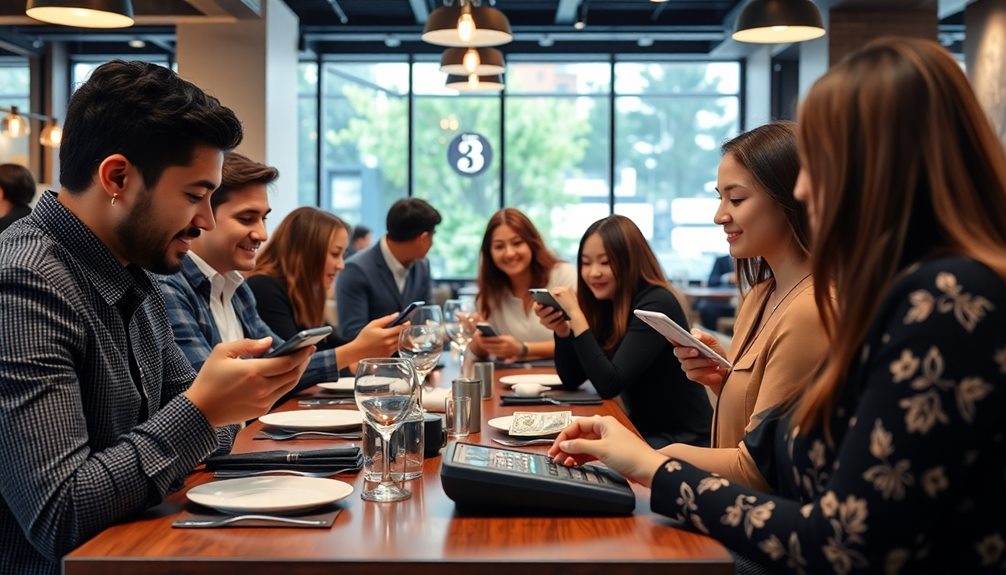Table-side cooking is making a strong comeback as diners seek engaging, hygienic, and personalized experiences. Enhanced safety measures like UV sterilization, touchless tools, and controlled environments address post-pandemic concerns, while technology like digital menus and augmented reality adds flair. Chefs create memorable dishes through live techniques, combining tradition with innovation. If you continue exploring, you’ll discover how safety, technology, and ambiance are shaping the future of this interactive dining trend.
Key Takeaways
- Post-COVID, table-side cooking emphasizes safety with enhanced hygiene measures like UV sterilization and touchless sanitizers.
- The trend revives interactive dining through live demonstrations, flambé, carving, and garnishing, creating memorable experiences.
- Technology integration, such as digital menus and augmented reality, enhances personalization, visualization, and safety in table-side dining.
- Controlled environment cooking ensures hygienic, precise preparations, reassuring customers and supporting the resurgence of table-side techniques.
- Ambience is elevated with cozy textiles and vintage decor, fostering lively atmospheres and shared memorable moments post-pandemic.
The Revival of Interactive Dining Experiences
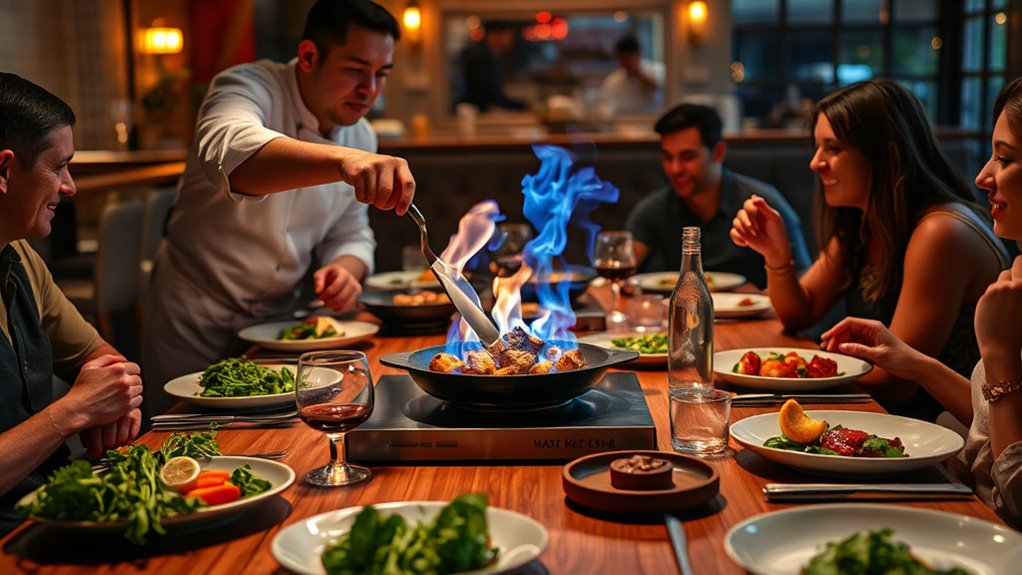
The resurgence of interactive dining experiences has transformed how you enjoy your meals, making the act of eating more engaging and memorable. Instead of passively consuming food, you become part of the culinary performance, participating directly in the preparation process. This shift heightens your sensory engagement, allowing you to savor flavors better and appreciate the skill behind each dish. Restaurants now craft environments where you can watch chefs craft your meal with flair, adding a sense of excitement and exclusivity. This trend taps into your desire for personalized, immersive experiences, creating stronger connections between you, your food, and the chef. Incorporating elements of cozy textiles and vintage decor can enhance the ambiance, making your dining experience feel even more special. As a result, dining becomes less about simply eating and more about creating lasting memories through shared, interactive moments.
Key Factors Fueling the Comeback of Table-Side Preparation
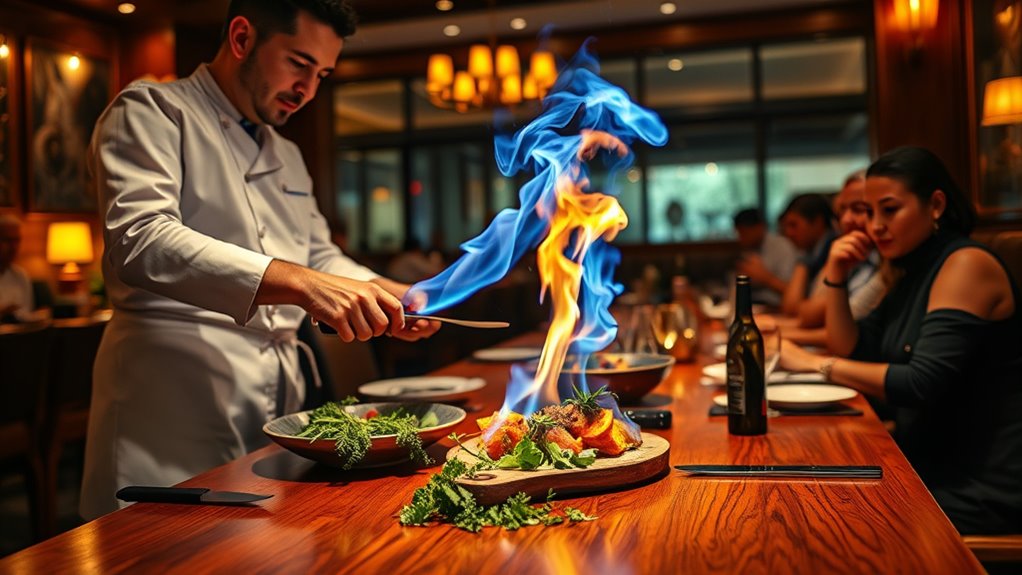
As diners increasingly seek unique and memorable experiences, several key factors are driving the renewed popularity of table-side preparation. First, the desire for personalized service makes guests feel more engaged, transforming a meal into an interactive event. Second, chefs see table-side techniques as a way to showcase their skills, adding excitement and artistry to the dining experience. Third, the visual appeal of live cooking creates a sense of theater that appeals to modern diners looking for entertainment with their meal. Additionally, the intimacy of table-side prep fosters a deeper connection between diners and staff, enhancing overall satisfaction. Finally, the COVID-19 pandemic has heightened awareness of safety and hygiene, prompting restaurants to emphasize visible, controlled preparation methods that reassure guests. Moreover, embracing creativity in presentation and technique can further elevate the dining experience and attract curious patrons.
Popular Dishes and Techniques in Modern Table-Side Cooking
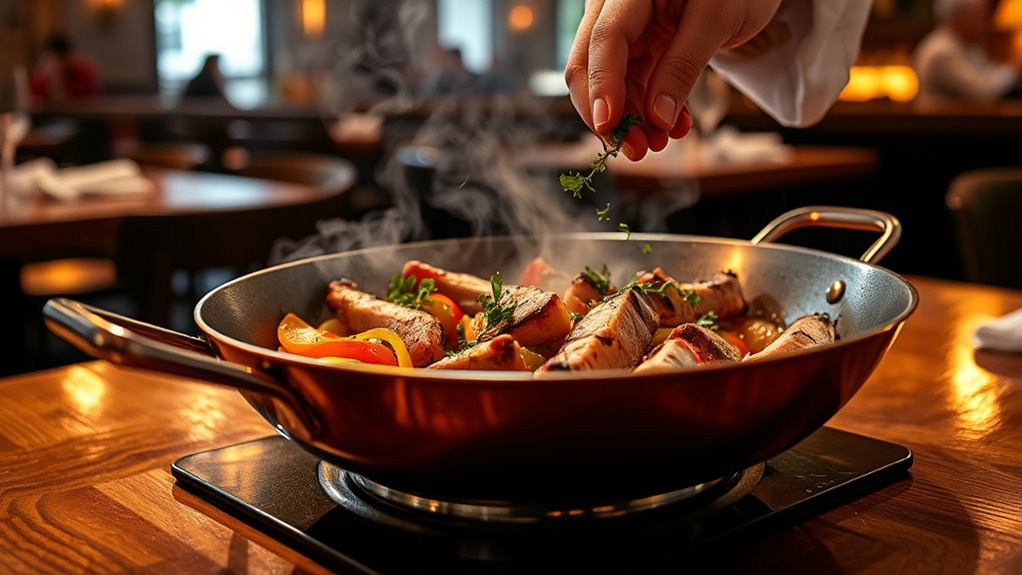
You’ll notice that interactive dining experiences and the revival of classic techniques are at the heart of modern table-side cooking. Dishes like tableside Caesar salads or flambé desserts create memorable moments for guests. These techniques blend tradition with innovation, making every meal both engaging and authentic. Incorporating unique and wicked planters into presentation setups can further elevate the dining experience by adding a touch of creativity and style.
Interactive Dining Experiences
Interactive dining experiences have gained popularity by bringing guests closer to the culinary process through engaging table-side techniques. You become part of the creation, making each dish memorable. Chefs now use flambéing, tableside carving, and personalized garnishes to thrill diners. These techniques encourage conversation and excitement, elevating the meal beyond just eating. Different dishes lend themselves to this approach, from sizzling steaks to colorful salads. To better understand, consider this table:
| Technique | Example Dish |
|---|---|
| Flambéing | Crêpes Suzette |
| Tableside Carving | Roasts and poultries |
| Personalized Garnishing | Cocktail presentations |
| Sizzling Serving | Fajitas and fajita platters |
These interactive elements turn a meal into an experience, creating lasting impressions and fostering a lively atmosphere. Additionally, understanding the divorce process in various states can shed light on how procedures are tailored to different legal systems.
Classic Techniques Revival
Reviving classic table-side techniques has become a popular trend, blending tradition with modern flair. You’ll see chefs expertly flambéing desserts, tossing salads, or carving roasts right at your table. These techniques create an interactive, engaging experience that adds excitement and a sense of craftsmanship. Popular dishes like Caesar salad tableside preparation or tableside steak carving evoke nostalgia while showcasing skill. The revival isn’t just about entertainment—it emphasizes quality, freshness, and presentation. Chefs now focus on perfecting these methods to impress diners and elevate the dining experience. This resurgence pays homage to culinary history while adapting techniques with contemporary twists. It’s about reconnecting with the artistry of cooking and making every meal memorable through the charm and precision of classic table-side methods. Additionally, emphasizing culinary techniques ensures that these performances remain both impressive and educational for diners.
Safety and Hygiene: How the Trend Addresses Post-Pandemic Concerns

Table-side cooking now emphasizes enhanced surface sanitization to reduce contamination risks. Controlled environment cooking helps limit exposure and maintain a safer space for both guests and staff. Additionally, strict personal hygiene measures guarantee everyone stays protected during the dining experience. Incorporating air purification technology such as portable air purifiers can further improve indoor air quality and reduce airborne pathogens.
Enhanced Surface Sanitization
As the focus on safety and hygiene remains a top priority post-pandemic, enhanced surface sanitization has become a key aspect of table-side cooking. You’ll notice new protocols and technologies designed to reduce contamination risks. For example, restaurants now use UV sterilizers and antimicrobial coatings on surfaces to kill bacteria and viruses instantly. You’re likely to see more frequent cleaning between courses, with staff wearing gloves and using sprays or wipes approved for food contact surfaces. Touchless dispensers for sanitizers and wipes help minimize contact. These measures reassure you that your dining experience prioritizes hygiene without sacrificing the interactive appeal of table-side service. Additionally, the use of essential oils for antimicrobial purposes in cleaning products is becoming more common, further enhancing sanitation efforts. By adopting these enhanced sanitization practices, establishments aim to create a safer environment, giving you peace of mind while enjoying your meal.
Controlled Environment Cooking
With heightened awareness of health risks, restaurants are increasingly turning to controlled environment cooking to guarantee safety and hygiene. This method minimizes contamination risks by maintaining strict temperature controls and reducing contact points. It also allows for better monitoring, ensuring consistent cooking standards and reducing the chance of undercooked food. Additionally, controlled environments facilitate faster sanitation processes, keeping kitchens cleaner and safer. Here’s how it enhances safety:
- Precise temperature regulation limits bacterial growth.
- Enclosed cooking spaces reduce airborne contamination.
- Automated systems minimize human contact with food.
- Consistent cooking processes improve food safety standards.
- Incorporating cultural breakfast traditions into controlled environments can enhance menu diversity while maintaining safety protocols.
Adopting controlled environment cooking not only reassures customers but also streamlines hygiene management, making your operation more resilient post-pandemic.
Personal Hygiene Measures
Controlled environment cooking has considerably improved kitchen safety by reducing contamination risks, but maintaining high hygiene standards also depends on strict personal hygiene practices. You should always wash your hands thoroughly before handling food or utensils, especially after touching surfaces or raw ingredients. Wearing clean aprons, hairnets, and gloves helps prevent cross-contamination. Avoid touching your face or other non-sterile surfaces during preparation. Use sanitized tools and regularly disinfect surfaces to keep bacteria at bay. Stay mindful of personal habits, like sneezing or coughing, and cover your mouth to prevent germs from spreading. Additionally, understanding food safety standards ensures that hygiene practices meet recommended guidelines. By following these hygiene measures diligently, you guarantee a safer dining experience for your guests and uphold the integrity of the table-side cooking trend post-pandemic.
Incorporating Technology Into Table-Side Culinary Service
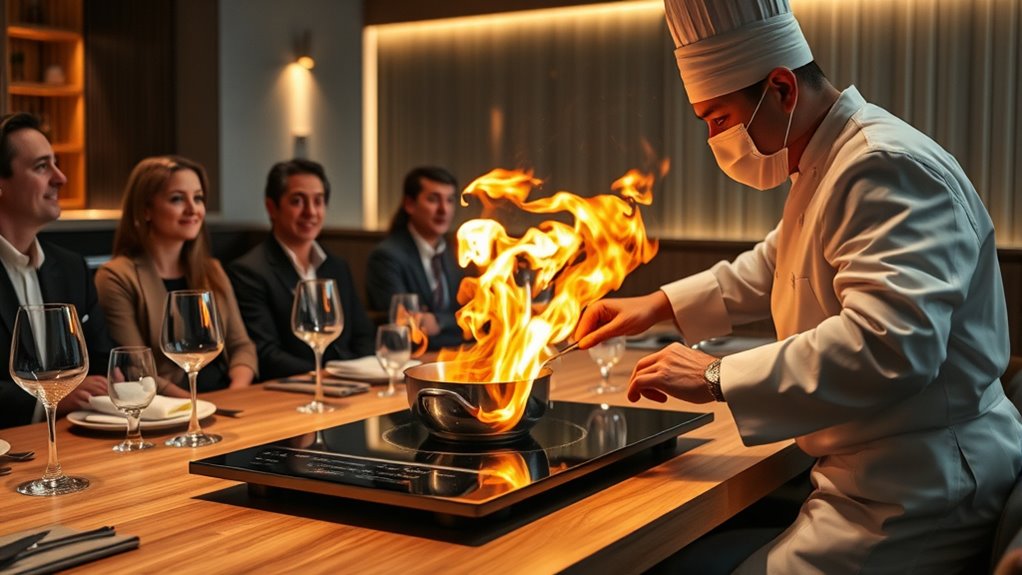
Incorporating technology into table-side culinary service has transformed the dining experience by making it more interactive and efficient. You can now engage diners with digital menus that offer detailed descriptions, images, and allergy information. Using tablets or smart screens, servers can quickly take orders and send them directly to the kitchen, reducing errors and wait times. Augmented reality (AR) tools enhance presentation, allowing guests to visualize dishes before ordering. Additionally, smart cooking devices enable precise control over preparation, ensuring consistency. Recognizing the importance of emotional connection in customer satisfaction can further enhance the dining experience. Additionally, smart cooking devices enable precise control over preparation, ensuring consistency.
What Diners Can Expect From the Future of Table-Side Dining

Advancements in table-side technology are setting the stage for a more personalized and immersive dining experience. Expect to see chefs using interactive displays, augmented reality, and smart tools to tailor dishes to your preferences. Future table-side service will likely emphasize engagement, with live demonstrations or customization options that make you feel involved in the process. Automation and robotics may handle routine tasks, freeing chefs to focus on creativity and presentation. Enhanced safety measures, like touchless interfaces and improved sanitation, will remain a priority. Overall, you’ll enjoy more dynamic, transparent, and memorable meals, where technology amplifies the sensory experience and deepens your connection with the culinary craft. The future promises a seamless blend of innovation and intimacy at your table.
Frequently Asked Questions
How Does Table-Side Cooking Impact Restaurant Staff Training Requirements?
You need to understand that table-side cooking increases staff training requirements markedly. You’ll have to guarantee your team masters specific techniques, safety procedures, and presentation skills to impress guests and prevent accidents. It also demands effective communication and coordination among staff, which means more thorough training sessions. Investing in ongoing education helps your staff deliver quality service and maintain safety standards, ultimately enhancing the dining experience and reputation of your restaurant.
Are There Specific Health Regulations for Table-Side Preparation Post-Covid?
Ever wondered if new health rules now govern how you prepare food at the table? Post-COVID, you need to stay alert, as specific health regulations may require you to follow stricter hygiene practices during table-side prep. These rules aim to protect both staff and guests, possibly including enhanced sanitization, PPE use, and social distancing measures. Staying compliant isn’t just about regulations; it’s about ensuring everyone’s safety and rebuilding trust.
What Are the Environmental Impacts of Increased Table-Side Dining Waste?
You might notice that increased table-side dining waste impacts the environment through more single-use items like napkins, utensils, and containers. This rise in waste contributes to landfills and pollution if not managed properly. You’re encouraged to support sustainable practices by choosing restaurants that minimize waste, recycle, or compost. Being mindful of your own waste helps reduce the environmental footprint of the growing trend of table-side dining.
How Do Cultural Differences Influence Table-Side Cooking Trends Worldwide?
Did you know that cultural differences markedly shape table-side cooking trends worldwide? In Japan, communal hot pots foster social bonding, while in Italy, tableside pasta preparation highlights culinary tradition. You’ll notice that local customs, ingredients, and dining etiquette influence how often and in what ways table-side cooking appears. You adapt to these cultural nuances, enriching your dining experience and understanding diverse culinary practices across different regions.
Can Table-Side Cooking Be Adapted for Allergy-Sensitive or Special Diets?
You can adapt table-side cooking for allergy-sensitive or special diets by clearly understanding your guests’ dietary restrictions. Use separate utensils and cookware to prevent cross-contamination, and select ingredients that meet their needs. Communicate openly with diners to ensure safety, and prepare alternative dishes if necessary. This approach not only shows care but also enhances the dining experience, making it inclusive and enjoyable for everyone at the table.
Conclusion
As you embrace the return of table-side cooking, imagine a dining experience where every dish becomes a shared story, a moment of connection amid a symphony of flavors. The trend isn’t just about food; it’s about reigniting the joy of interaction, trust, and innovation. Like a flame rekindled after a long pause, table-side dining promises a future where your meal is an experience as memorable as the flavors on your plate.



